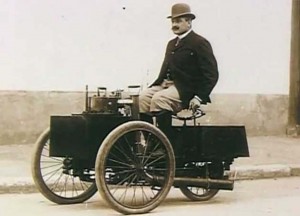The name alone might explain why they didn’t sell more. The world’s oldest running automobile carries a name that would almost wrap around its tiny body. But expect that someone will be writing a check with nearly as long a price tag when an 1884 De Dion Bouton et Trepardoux Dos-a-Dos Steam Runabout goes on the RM Auction block next month in Hershey, Pennsylvania.
And it will get there under its own power. A total of just 20 of the tricycle-style De Dions were produced in 1884, of which only six are known to survive. And the one being auctioned off is the only copy that can still run under its own power.
At 127 years of age, the Runabout raises a question about who actually created the modern automobile. Mercedes-Benz, which is generally given credit, is just celebrating its 125th anniversary. But the German marque’s first offering introduced the idea of using petroleum to power an internal combustion engine. The De Dion was a steam-powered cruiser.
Nonetheless, it delivered impressive performance for its day, achieving a claimed top speed of 38 miles per hour with a range of 20 miles on a 40-gallon tank of water.
Nicknamed “La Marquise,” in honor of Count De Dion’s mother, the 9-foot-long steamer seats four, front and rear passengers sitting back-to-back, which is why it was known as a dos-a-dos. The Runabout uses a tiller-like spade handle for steering. The boiler is located under the seats. Using coke or coal it takes 45 minutes to build up the necessary head of steam to get it moving. Two independent engines are used, one for each of the front wheels.
It won what is claimed to have been the world’s first automobile race; and though it was the only entrant it nonetheless reached a top speed of 37 mph and averaging 18 mph over the 20-mile course.
The 1884 De Dion Bouton et Trepardoux Dos-a-Dos Steam Runabout has had only four owners, the last family holding onto it for 81 years.
RM estimates it will command a winning bid of anywhere from $2 million to $2.5 million.


Mercedes’ continual 1886 claim of “first automobile” is a great example of winners (or in this case, the advertising departments of survivors) writing history. It’s been repeated so many times that even the library of congress now publishes it as a “fact”.
By 1893, Frank and Charles Duryea had already demonstrated a vehicle. On Thanksgiving Day 1895, Frank won the Chicago Times Herald Race traveling 54 miles with an average speed of 7.5 mph. In 1895, the Duryea Motor Wagon Company started commercial production of the first American car.
I might add that all of these vehicles were 4-wheeled, and had more in common with a modern automobile than the Benz motorized tricycle of 1886.
Trying to assign sole automobile-inventor status is about as subjective as claiming “World’s best pizza”. There is no one answer. Only the most arrogant of companies would attempt to claim such a title. Only the modern American-inferiority complex would allow us to vitrually wipe the Duryea brothers from history.
Now, wait a sec, Carmine, are you telling me you wouldn’t chose Sally’s, or at least Pepe’s pizza, in New Haven?
Your points, to be more serious, are very well taken. To the victors (or survivors, anyway), go the spoils.
Paul A. Eisenstein
Publisher, TheDetroitBureau.com